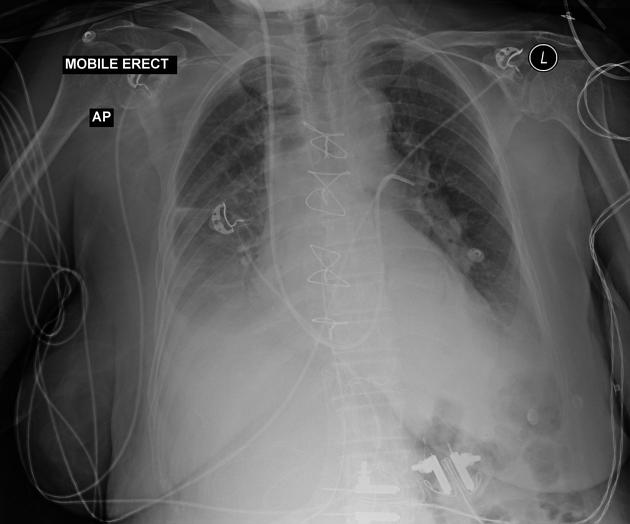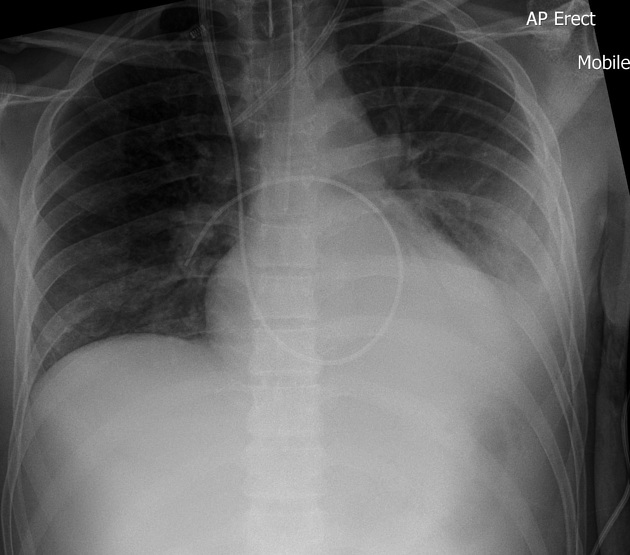Pulmonary artery catheter
Citation, DOI, disclosures and article data
At the time the article was created Daniel J Bell had no recorded disclosures.
View Daniel J Bell's current disclosuresAt the time the article was last revised Joshua Yap had no financial relationships to ineligible companies to disclose.
View Joshua Yap's current disclosures- Swan-Ganz catheters
- Swan-Ganz catheter
- Swan Ganz catheters
- Swan Ganz catheter
- Pulmonary artery catheters
- PAC
Pulmonary artery catheters (PAC or Swan-Ganz catheters) are balloon flotation catheters that are inserted into the pulmonary arteries. They can be inserted simply, quickly, with little training and without fluoroscopic guidance at the bedside, even in the seriously ill patient.
Usage
Historically, pulmonary artery catheters were widely used to measure right heart hemodynamic indices and pulmonary arterial and capillary wedge pressures. Their use has since fallen out of favor due to adverse trial data 1. However, they still have important niche uses.
These catheters should ideally be positioned in the proximal right or left main pulmonary artery.
History and etymology
The first balloon flotation flow-directed catheter that did not require image-guidance for insertion and therefore could be inserted at the bedside was introduced in 1970 2 by William Ganz (1919-2009) 3 and Harold James Charles "Jeremy" Swan (1922-2005) 4, both cardiologists at Cedars-Sinai Hospital, Los Angeles.
References
- 1. Elay G, Clinic of Intensive Care, Dr. Ersin Arslan Training and Research Hospital, Gaziantep, Turkey, Coskun R et al. Comparison of Pulmonary Artery Catheter and Central Venous Catheter for Early Goal Directed Targeted Therapy in Sepsis and Septic Shock. Eur J Ther. 2019;25(4):253-8. doi:10.5152/eurjther.2019.18020
- 2. Chatterjee K. The Swan-Ganz Catheters: Past, Present, and Future. A Viewpoint. Circulation. 2009;119(1):147-52. doi:10.1161/CIRCULATIONAHA.108.811141 - Pubmed
- 3. Dr. William Ganz Dies at 90; Cardiologist Co-Invented Flexible Balloon Catheter. Los Angeles Times.
- 4. Bayliss M, Andrade J, Heydari B, Ignaszewski A. Jeremy Swan and the pulmonary artery catheter: Paving the way for effective hemodynamic monitoring. BCMJ, Vol. 51, No. 7, September, 2009, page(s) 302-307. http://www.bcmj.org/article/jeremy-swan-and-pulmonary-artery-catheter-paving-way-effective-hemodynamic-monitoring [accessed online on 16.10.2017].
Incoming Links
Related articles: Chest
- imaging techniques
-
chest radiograph
- radiography[+][+]
-
approach
- ABCDE
- ABCDEFGHI
- congenital heart disease
- medical devices in the thorax
- common lines and tubes
- nasogastric tubes[+][+]
- endotracheal tubes[+][+]
-
central venous catheters
-
jugular venous catheter
- Groshong catheter
- Hickman catheter
- pulmonary artery (Swan-Ganz) catheter
- peripherally inserted central catheters
- differential of left paramediastinal catheter positions
-
jugular venous catheter
- esophageal temperature probe
- tracheostomy tube
- pleural catheters
- cardiac conduction devices
- prosthetic heart valve
- review areas
-
airspace opacification[+][+]
- differential diagnoses of airspace opacification
- lobar consolidation
-
atelectasis
- mechanism-based
- morphology-based
- lobar lung collapse
- chest x-ray in the exam setting[+][+]
- cardiomediastinal contour[+][+]
- chest radiograph zones[+][+]
- tracheal air column[+][+]
- fissures[+][+]
- normal chest x-ray appearance of the diaphragm[+][+]
- nipple shadow[+][+]
-
lines and stripes[+][+]
- anterior junction line
- posterior junction line
- right paratracheal stripe
- left paratracheal stripe
- posterior tracheal stripe/tracheo-esophageal stripe
- posterior wall of bronchus intermedius
- right paraspinal line
- left paraspinal line
- aortic-pulmonary stripe
- aortopulmonary window
- azygo-esophageal recess
- spaces[+][+]
- signs[+][+]
- air bronchogram
- big rib sign
- Chang sign
- Chen sign
- coin lesion
- continuous diaphragm sign
- dense hilum sign
- double contour sign
- egg-on-a-string sign
- extrapleural sign
- finger in glove sign
- flat waist sign
- Fleischner sign
- ginkgo leaf sign
- Golden S sign
- Hampton hump
- haystack sign
- hilum convergence sign
- hilum overlay sign
- Hoffman-Rigler sign
- holly leaf sign
- incomplete border sign
- juxtaphrenic peak sign
- Kirklin sign
- medial stripe sign
- melting ice cube sign
- more black sign
- Naclerio V sign
- Palla sign
- pericardial fat tag sign
- Shmoo sign
- silhouette sign
- snowman sign
- spinnaker sign
- steeple sign
- straight left heart border sign
- third mogul sign
- tram-track sign
- walking man sign
- water bottle sign
- wave sign
- Westermark sign
- HRCT[+][+]
-
chest radiograph
- airways[+][+]
- bronchitis
- small airways disease
-
bronchiectasis
- broncho-arterial ratio
- related conditions
- differentials by distribution
- narrowing
-
tracheal stenosis
- diffuse tracheal narrowing (differential)
-
bronchial stenosis
- diffuse airway narrowing (differential)
-
tracheal stenosis
- diverticula
- pulmonary edema[+][+]
-
interstitial lung disease (ILD)[+][+]
- Anti-Jo-1 antibody-positive interstitial lung disease
- drug-induced interstitial lung disease
-
hypersensitivity pneumonitis
- acute hypersensitivity pneumonitis
- subacute hypersensitivity pneumonitis
- chronic hypersensitivity pneumonitis
- etiology
- bird fancier's lung: pigeon fancier's lung
- farmer's lung
- cheese workers' lung
- bagassosis
- mushroom worker’s lung
- malt worker’s lung
- maple bark disease
- hot tub lung
- wine maker’s lung
- woodsman’s disease
- thatched roof lung
- tobacco grower’s lung
- potato riddler’s lung
- summer-type pneumonitis
- dry rot lung
- machine operator’s lung
- humidifier lung
- shower curtain disease
- furrier’s lung
- miller’s lung
- lycoperdonosis
- saxophone lung
-
idiopathic interstitial pneumonia (mnemonic)
- acute interstitial pneumonia (AIP)
- cryptogenic organizing pneumonia (COP)
- desquamative interstitial pneumonia (DIP)
- non-specific interstitial pneumonia (NSIP)
- idiopathic pleuroparenchymal fibroelastosis
- lymphoid interstitial pneumonia (LIP)
- respiratory bronchiolitis–associated interstitial lung disease (RB-ILD)
- usual interstitial pneumonia / idiopathic pulmonary fibrosis (UIP/IPF)
-
pneumoconioses
- fibrotic
- non-fibrotic
-
lung cancer[+][+]
-
non-small-cell lung cancer
-
adenocarcinoma
- pre-invasive tumors
- minimally invasive tumors
- invasive tumors
- variants of invasive carcinoma
- described imaging features
- adenosquamous carcinoma
- large cell carcinoma
- primary sarcomatoid carcinoma of the lung
- squamous cell carcinoma
- salivary gland-type tumors
-
adenocarcinoma
- pulmonary neuroendocrine tumors
- preinvasive lesions
-
lung cancer invasion patterns
- tumor spread through air spaces (STAS)
- presence of non-lepidic patterns such as acinar, papillary, solid, or micropapillary
- myofibroblastic stroma associated with invasive tumor cells
- pleural invasion
- vascular invasion
- tumors by location
- benign neoplasms
- pulmonary metastases
- lung cancer screening
- lung cancer staging
-
non-small-cell lung cancer






 Unable to process the form. Check for errors and try again.
Unable to process the form. Check for errors and try again.